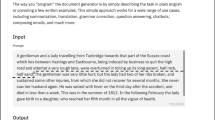Abstract
We consider two issues relating to WH-questions:
(i) when you ask aWH-question you already have a description of the entity you are interested in,namely the description embodied in the question itself. You may evenhave very direct access to the entity – see (1) below.In general, what you want is an alternative description of some item thatyou already know a certain amount about.
(ii) the person attempting to answer the question may not be able to lay theirhands on an example, but they may know what they are like, how you recognisethem, where you can get them. If someone asks me “Where can I buy an Italiannewspaper?” then it is better to give them a generic answer like“In any large newsagent.” than to just say “I don't know.”
We argue that attempting to deal with these issues requires the person (or system) trying to come up with an answer to reason about thedescription embodied in the question, and we describe a system that is capableof carrying out such reasoning.
Similar content being viewed by others
References
Allen, J.F. and Perrault, C.R., 1980, “Analysing intention in utterances,” Artificial Intelligence 15, 148-178.
Austin, J., 1962, How to Do Things with Words, Oxford: Oxford University Press.
Barwise, J. and Perry, J., 1983, Situations and Attitudes, Cambridge, MA: Bradford Books.
Baumgartner, P. and Kühn, M., 2000, “Abducing coreference by model construction,” Journal of Language and Computation 1, 183-197.
Cohen, P.R. and Perrault, C.R., 1979, “Elements of a plan-based theory of speech acts,” Cognitive Science 7, 171-190.
Dale, R. and Reiter, E., 1995, “Computational interpretations of the Gricean maxims in the generation of referring expressions,” Cognitive Science 19, 233-263.
Dowty, D.R., 1989, “On the semantic content of the notion of ‘thematic role’,” pp. 69-130 in Properties, Types and Meaning II: Semantic Issues, G. Chierchia, B.H. Partee, and R. Turner, eds., Dordrecht: Kluwer Academic Publishers.
Dowty, D.R., 1991, “Thematic proto-roles and argument selection,” Language 67, 547-619.
Gabbay, D.M., 1996, Labelled Deductive Systems, Oxford: Oxford University Press.
Gardent, C. and Konrad, K., 2000, “Interpreting definites using model generation,” Journal of Language and Computation 1, 215-230.
Ginzburg, J., 1996, “The semantics of interrogatives,” pp. 385-422 in Handbook of Contemporary Semantic Theory, S. Lappin, ed., Oxford: Blackwell.
Green, C., 1969, “Theorem proving as a basis for question-answering systems,” pp. 183-205 in Machine Intelligence 4, B. Meltzer, and D. Michie, eds., Edinburgh: Edinburgh University Press.
Green, C. and Raphael, B., 1968, “The use of automated theorem proving techniques in question-answering systems,” pp. 169-181 in Proceedings of the 23rd National Conference of the ACM, R.B. Blue Sr. and A.M. Rosenberg, eds., ACM Press.
Grice, H.P., 1975, “Logic and conversation,” pp. 41-58 in Speech Acts, P. Cole and J.L. Morgan, eds., London: Academic Press.
Groenendijk, J. and Stokhof, M., 1997, “Questions,” pp. 1055-1124 in Handbook of Logic and Language, J. van Benthem and A. ter Meulen, eds., Amsterdam/Cambridge, MA: Elsevier/MIT Press.
Manthey, R. and Bry, F., 1988, “Satchmo: A theorem prover in Prolog,” pp. 415-434 in Proceedings of the 9th International Conference on Automated Deduction (CADE-9), R. Lusk and R. Overbeek, eds., Lecture Notes in Artificial Intelligence, Vol. 310, Berlin: Springer-Verlag.
Miller, D., Nadathur, G., Pfennig, F., and Scedrov, A., 1991, “Uniform proofs as a foundation for logic programming,” Annals of Pure and Applied Logic 51, 125-157.
Ramsay, A.M., 1999a, “Dynamic and underspecified semantics without dynamic and underspecified logic,” pp. 208-220 in Computing Meaning, Vol. 1, H. Bunt, L. Kievit, R. Muskens, and M. Verlinden, eds., Dordrecht: Kluwer Academic Publishers.
Ramsay, A.M., 1999b, “Weak lexical semantics and multiple views,” pp. 205-218 in 3rd International Workshop on Computational Semantics, H.C. Bunt and E.G.C. Thijsse, eds., University of Tilburg.
Ramsay, A.M., 2001, “Theorem proving for untyped constructive ?-calculus: Implementation and application,” Logic Journal of the Interest Group in Pure and Applied Logics 9, 89-106.
Ramsay, A.M. and Seville, H., 2000, “Models and discourse models,” Journal of Language and Computation 1, 167-181.
Reiter, R., 1980, “A logic for default reasoning,” Artificial Intelligence 13, 81-132.
Searle, J.R., 1969, Speech Acts: An Essay in the Philosophy of Language, Cambridge, MA: Cambridge University Press.
Seville, H. and Ramsay, A.M., 2000, “Making sense of reference to the unfamiliar,” pp. 775-781 in Proceedings of the 18th International Conference on Computational Linguistics (COLING-2000), M. Kay, ed., Universität des Saarlandes.
van Deemter, K., 2000, “Generating referring expressions: Beyond the incremental algorithm,” pp. 50-66 in 4th International Workshop on Computational Semantics, H.C. Bunt, ed., University of Tilburg.
van der Sandt, R., 1992, “Presupposition projection as anaphora resolution,” Journal of Semantics 9, 333-377.
Warren, D.H.D. and Pereira, F.C.N., 1982, “An efficient easily adaptable system for interpreting natural language queries,” American Journal for Computational Linguistics 8, 110-122.
Wedekind, J., 1996, “On inference-based procedures for lexical disambiguation,” pp. 980-985 in Proceedings of the 16th International Conference on Computational Linguistics (COLING-96), Copenhagen, J.-I. Tsujii, ed., Copenhagen: Center for Sprogteknologi.
Author information
Authors and Affiliations
Rights and permissions
About this article
Cite this article
Gaylard, H., Ramsay, A. Relevant Answers to WH-Questions. Journal of Logic, Language and Information 13, 173–186 (2004). https://doi.org/10.1023/B:JLLI.0000024733.79286.27
Issue Date:
DOI: https://doi.org/10.1023/B:JLLI.0000024733.79286.27




